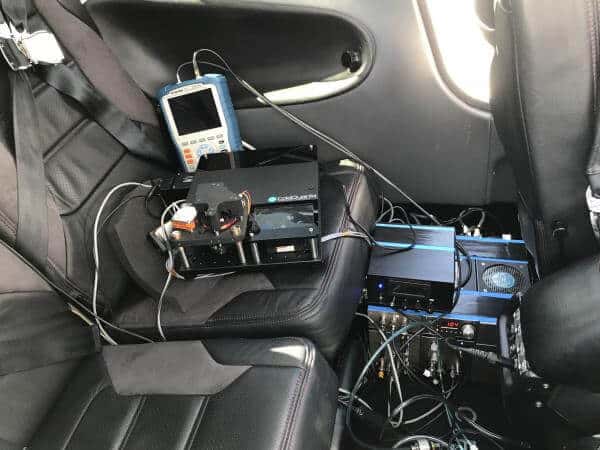On a recent warm, sunny morning at Boulder’s municipal airport, CU Boulder physics professor and JILA Fellow Dana Anderson stood on the tarmac with his colleagues preparing to take to the skies with some very, very cold atoms.
Perched on the wing of a single-propeller airplane, Anderson leaned inside the fuselage to make a few final adjustments on the equipment tucked into the back seat. The setup is only about the size of a stereo amp, but harnesses a marvel of physics: a tiny cloud of around 10 million individual atoms, cooled to near absolute zero and locked in place by lasers with a force of about 1,000 G’s — nearly 100 times the g-force that a human traveling in a supersonic fighter jet would experience.
Anderson hopes that this delicate magneto-optical trap, or MOT, will prove robust enough to hold up to vibrations and radio signals during the roughly 75-minute roundtrip flight to Cheyenne, Wyoming. Ultracold atoms are typically created under highly controlled laboratory conditions and the day’s demonstration is one of the first known attempt to take a MOT airborne as passenger on an ordinary civilian airplane.
“It’s exciting, and that’s why we do it,” said Anderson, the current chair of JILA, a joint institute of CU Boulder and the National Institute of Standards and Technology.
The science behind condensed matter physics is not brand new by any means, but the range of potential applications has only grown in recent decades. Eric Cornell and Carl Wieman of CU Boulder and JILA shared the 2001 Nobel Prize in Physics for the successful creation of a Bose-Einstein condensate (BEC), a new form of matter in which bosons are cooled down to occupy their lowest quantum state.
Anderson, who collaborated with Cornell and Wieman, has spent years researching how these ultracold atoms might be integrated into next-generation aerospace sensors and navigation devices. When atoms are cooled to near absolute zero, they begin to take on more fundamental sensitivity due to strong interaction with gravity and magnetic fields.
Once cooled and trapped in place by the lasers in a MOT environment, these ultracold atom populations become useful for inertial sensing, providing information equivalent to that of an accelerometer (which measures velocity change in a straight line) and a gyroscope (which measures rotation). Both are essential tools for aviation.
Atomic inertial sensing, once improved and perfected for travel, would be considered far more reliable and accurate than the currently ubiquitous GPS technology, which relies on satellite data to pinpoint location.
“GPS is delicate and can be jammed easily, either intentionally or accidentally,” said Anderson. “You’d like to be able to know where you’re going without it…we’re not yet at the point where we could fly from Boulder to JFK airport with our eyes closed.”
In 2007, Anderson founded ColdQuanta, a Boulder-based startup company, in order to further his ultracold atom research and create commercial applications for the technology. This latest mini-MOT created by ColdQuanta was engineered mostly from glass, ceramic and silicon rather than metal in order to create a unit small enough to travel in a plane — no easy design feat.
Vescent Photonics, a JILA spinoff company that creates electro-optic technologies, provided the laser components for the MOT.
Anderson hopped into the cockpit and put on a headset, ready to fly the plane to Cheyenne while his colleagues Jaime Ramirez-Serrano and Janet Duggan, both ColdQuanta scientists, ride along to monitor the equipment in real-time. After the flight, the researchers plan to analyze the data and see how the MOT held up in order to continue tweaking the design.
With final preparations complete, the plane is cleared for takeoff. Amidst cheers from onlookers representing the scientific staffs of both ColdQuanta and Vescent, Anderson fired up the engine. The small plane taxied to the edge of the runway and took off smoothly into the morning sunshine.


